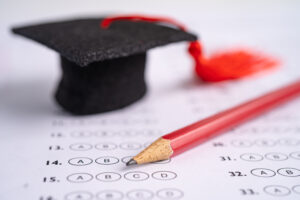We’ve covered the topic of doing research before, talking about how you can conduct research as a high school student, and how you can write papers about your findings. Of course, the ultimate goal of conducting research is publication; sharing your discoveries with the broader scientific community, and contributing to the overall growth of knowledge.
In this article, we’re going to cover how papers are handled and reviewed once they are sent in for publication. We’ll cover editing, the peer review process, and how the inner functions of journals work. We’ll also cover the differences between high school and professional journals, and show you how you can make sure your papers are more likely to be published. Let’s get started!
Standards for Submission
Before doing anything else, you need to make sure your paper meets the standards for submission for the journal in question. Each journal has their own standards for formatting and content, and your submission should match these exactly. As an example, here are the publication standards for the Journal of Emerging Investigators, one of the top high school journals.
This particular journal actually gives you a template to work with; professional journals do not do this, but they still expect you to follow their standards. Each subsection then has its own standards for content, formatting, and the inclusion of figures. Figures and references have their own guidelines.
How you format your references matters. Journals generally use Chicago or APA style citations, but each has their own standards for in text, footnote, or endnote citations, and the bibliography. Figures again need to be formatted, numbered, and captioned according to their guidelines.
The purpose of these standards is to allow for the easy publication of articles, to make sure that what you have written will fit physically within the pages of their journal. These vary slightly between journals, though they are generally similar. Still, you should check them and re-edit your paper before submitting it to any additional journals.
Submitting to Multiple Journals
Many, though not all, journals require that you not submit your research to other journals for publication while they are reviewing your paper. They require you to affirm this before they will review your paper for publication.
The reason they do this is to avoid duplicate publication of research. Because different journals have different review processes, they don’t want to invest the time needed to review your work, only to find it has already been published by another organization. If a journal rejects your paper, then you may submit it to another journal, but simultaneous submission is usually not possible.
The Initial Review: Editors
When your paper is first submitted, it is reviewed by an editor (or associate editor) at the journal. They go through it as an initial review and check the following:
- Does your paper meet the submission standards in terms of formatting?
- What is your paper arguing? What question were you asking, and what result did you get?
- What methodology did you use to gather data, and was it reliable and replicable?
- What methodology did you use to analyze your data?
- What conclusions did you draw, what sources of error did you have, and what margin of error did you encounter?
- Does your research contribute meaningfully to the field in question?
- Can your research be built upon further?
How strict journals are with these requirements varies, but generally the more prestigious a journal is, the higher the standards they have. High school journals sometimes have more leeway, since they know you are still a student, but you should still work to ensure that your paper meets all of their formatting guidelines.
The review for quality of research is preliminary; it isn’t to take the place of peer review, but instead to see if your paper has the quality needed to be worth peer reviewing. Editors generally have familiarity with the field, but may not be experts on the exact subject in question. Journals which publish in multiple fields, like many high school journals, will give papers to editors familiar with the field of study.
Professional journals are more focused in terms of the topics they cover, and editors of these journals are experts in these fields themselves. Indeed, for some academics becoming the editor of a journal is the next logical career step, and many will serve as a journal editor or associate at some point.
If your paper does not meet submission standards, it may get returned to you with requested corrections, or may simply get rejected, depending on the journal in question. Most will simply reject papers at this stage if they do not meet all of their posted requirements, both at the high school and professional level. Some will return papers with notes for correction before they will be considered for peer review. You will usually have a few weeks to make any needed corrections.
To maximize your chances of getting your paper published, you should do the following before the paper is submitted to the editor:
- Make sure you follow the style guide for formatting and citations exactly.
- Make sure your research goals and conclusions are clearly stated, your methodology is clearly laid out, and your paper is organized to be easily understood.
- Make sure any sources of error are discussed.
How the Peer Review Process Works
Peer review is what makes academic publishing prestigious and credible, as it’s the process which makes sure that all new research published stands up to the highest scrutiny. Peer review is done by experts in the field (the author’s peers so to speak), and they are the arbiters of whether the research is valid and worth publishing.
There are several ways that peer review can work, and it does vary somewhat by field. Many journals have set peer reviewers they work with; as the field of scope for many journals is small, they have a limited selection of experts who can properly judge the papers submitted. These reviewers are either volunteers or paid, depending on the journal in question and their resources, but most work as volunteers. Again, serving as a peer reviewer is often an important step in a career as an academic.
Reviewers can be open, blind, or double blind. Some professors, when submitting a paper, will specifically request one of their fellows to review it, though this is less common. More often, reviews are blind, where the author does not know who is reviewing their work. More often, they are double blind, where the reviewers do not know the identity of the author, and the authors do not know the reviewers.
The goal with this is to prevent bias or politics from impacting reviews, especially since academic politics often leads to long grudges. This can occasionally cause problems, such as one author who kept having papers rejected for not properly discussing the works of a major contributor to her field – herself. That said, double blind reviews are the most common, and have the fewest problems.
Most high school journals use blind or double blind reviews, and rely on academics volunteering their time for the most part. Most have a number of reviewers they work with for each subject. Papers, regardless of level, have between one and three reviewers, though three is most common.
Each reviewer reads the paper and gives their thoughts. From here, the paper is either published, returned to the author for corrections, or rejected. A return with corrections is more common at the professional level than the high school level, though this can also vary by journal. The Journal of Emerging Investigators, for example, is well known to return papers to authors with notes for how they need to correct it before publication.
Reviewers are looking for the following things in a paper:
- That you have considered existing work in the field, and that the work you’re doing clearly builds upon it.
- That you’re asking a clear question, and that any conclusions you draw are relevant to the field as a whole.
- That your methodology is replicable, and has taken steps to eliminate or mitigate sources of error.
Problems with data gathering or methodology may result in a paper being rejected entirely, whereas issues with a literature review or analysis are more likely to get notes for correction. Notes from reviewers are presented sequentially, rather than together, so you will be able to see what each thinks you need to work on if your paper is returned.
We will note that many high school journals do not do this, and instead simply reject papers which do not pass peer review. This is due to the number of submissions they receive, and the limited time of reviewers. We therefore recommend you get your papers to the highest possible level before submitting them to a journal, as you may only get one chance.
A Note on Preprints
Preprints are articles which are published before undergoing the peer review process. They are generally held in lower esteem, since they have not undergone the most rigorous aspect of the publication process. This is true for academic papers at all levels of research.
Some preprints are circulated to generate public interest in a topic before the peer review process is completed, but this is mostly true for major breakthroughs in fields like medicine. We recommend high school students avoid preprints if they are trying to conduct serious research. Getting critiqued and advised by reviewers is a key part of the research process, and participating in it will make you a better scholar.
Final Thoughts
Publishing research is the ultimate culmination of academic success, and the review process exists to make sure that all published research is of the highest standards. Of course, not all journals are scrupulous, and some will charge high fees of authors and publish without review at all. These are held in low esteem by academics, seen as scams taking advantage of the unwary.
If you want help conducting research of your own, or advice on submitting it for publication, or just help with polishing what you’ve written, schedule a free consultation today to learn how we can help you. We have helped high school students get published in both high school and professional journals, and would love to discuss your research with you.








